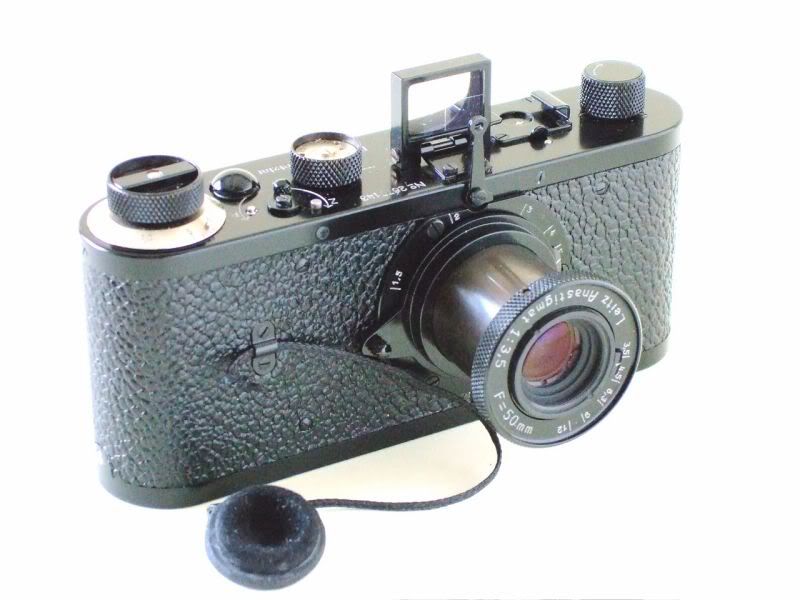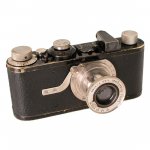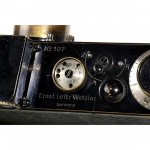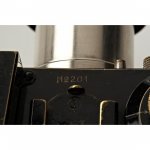This is part of a Leica "O" photo essay I prepared for the photographic section of another non-camera forum:
This is the Leica "O" Replica camera:
It is just as Oskar Barnack originally designed it hence the unfamiliar controls and querky method of operation. Unlike the 1925 Leica I, the model "O" does not have a self-capping focal plane shutter. The lens cap on a cord was designed to be placed over the lens every time the shutter is wound on to avoid fogging the film. Shutter cocking/film winding is straightforward for any preset shutter speed. But
changing the actual shutter speed complicates matters because the shutter slit width between the first and second shutter curtains can only be altered when the shutter is
partially wound and when the first of the two shutter blinds is completely in front of the film plane window. The slit width cannot be altered when the shutter is fully cocked or immediately after it is fired. The actual slit widths, as distinct from shutter speeds, are shown on the shutter speed "setting knob" . The widths correspond to the speeds as follows:
2mm = 1/500 sec
5mm = 1/200 sec
10mm = 1/100 sec
20mm = 1/50 sec
50mm = 1/20 sec
Here is a close-up of the the shutter setting knob and wind-on with the shutter cocked and ready to fire at 1/50 sec.
The pin indicator in the setting knob shows 20mm
And here is the setting knob after the shutter has fired ... pin still in the 20mm slit width position
Suppose the shutter speed for the next exposure requires changing to 1/500 second ie 2mm blind slit width. The shutter now needs
partially winding on ... but throughout this procedure the lens cap must be placed over the lens. This avoids fogging the film through the uncapped shutter blind slit as the blinds are wound back off the take-up drum. Note the red dot on the setting knob. When the wind-on is turned, the setting knob also turns. Thus by
partially turning the wind-on, the red dot can be aligned with the indicator line on the LHS. Only in this position is the first shutter blind completely in front of the film plane. And only in this position can the outer knurled sheath surrounding the setting knob be pushed down and turned, to slip the indicator pin into alterrnative slit width positions.
Here the wind-on has been being partially turned to align the red dot
And here the setting knob sheath has been pushed down (with the red dot still aligned) and turned to slip the indicator pin into the 2mm position i.e 1/500 sec.
And here the wind-on knob has been fully turned to cock the shutter with the new 2mm slit width.
It is a rather long winded :wink: procedure and also risks fogging the film if the lens is not capped.
Furthermore, the slit widths and corresponding speeds require memorizing or writing down.
But these complications are not the only idiosyncrasies because the cross hair viewfinder cannot be used close to the eye ... it can only be used at a viewing distance of 25-30cm in order that the cross hairs can be aligned with the sight-hole. This does not permit steady viewing or steady shutter operation. The camera would be more stable if held conventionally against the face. This can be achieved by using a conventional accessory viewfinder as shown below. Here the Leitz SBOOI 12015 has been used. The photograph also shows a lens hood being used about which more later.
The cross hair finder can now be folded against the top plate and used to hold a thin piece of card on which are written the corresponding shutter speeds for each slit width ... obviating the need to memorize which speeds correspond with the respective slit widths.
However, the lens still needs capping each time the shutter is wound on and then uncapping again before making the exposure. But, the capping procedure can be speeded up if a lens hood is used thus permitting capping with the palm of the hand instead of the cap on the cord. This sounds a bit risky but the hood fits "light-tight" around the lens and the palm can be totally "cupped" over the front thus capping the lens.
Whilst not in the true Barnack Leica "O" tradition these modifications do permit faster operation ... and also enable the use of the superb recomputed Anastigmat lens ... and at reasonable cost judging by the current used "O" prices.
I will add some photographs taken with the camera soon.
Watch this space.
Cheers
dunk














